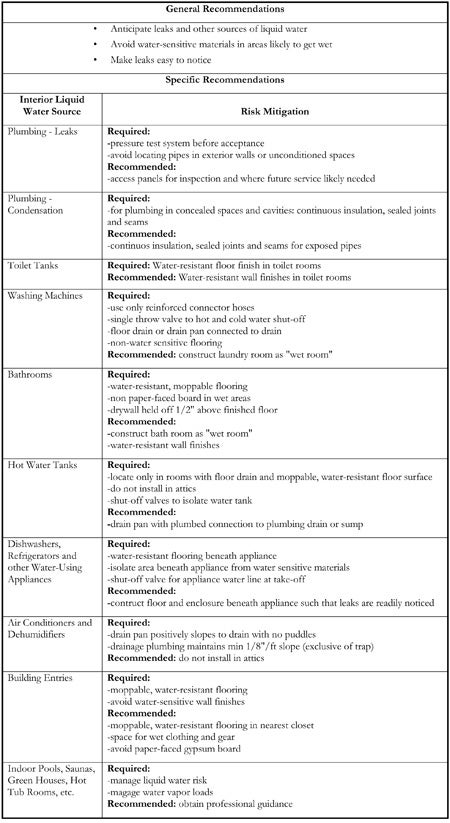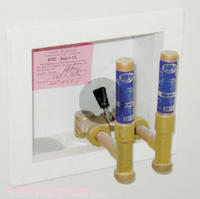Managing exterior sources of liquid water, i.e. rainwater and groundwater, are one of the principal functions of the building enclosure system, and site work (refer to Information Sheets 101, and 301, 302, 303, 304 and 305). But sources of liquid water are not limited to the outside of the building. Plumbing and occupant behavior also represent potential sources of damaging liquid water entry and accumulation in buildings. These interior water sources should be anticipated in design and construction.
Water accumulation inside the building presents risks to occupant health as it can lead to growth of mold, support pest populations, and cause other IAQ problems. Accumulation of water inside the building can also be detrimental to building durability by causing rot and deterioration of building materials and by enabling damaging pest populations.
While it is true that new plumbing systems should not leak, it is reasonable to expect that even the best plumbing systems will develop problems over time. When plumbing equipment, water-using devices, or washing appliances fail they can result it catastrophic water leakage. Also accidents (e.g. over-watering house plants) and improper use of equipment (e.g. plugging overflow drains on a sink) happen. Finally, some interior water entry (e.g. water splashing out of tub, water dripping off boots and umbrella’s near an entry) is a completely normal part of using the building. The risks represented by all of these factors can be managed with interior water management techniques.
Plumbing Pipes
Plumbing pipes represent a potential liquid water source in two ways: 1) they may develop leaks, and 2) water may condense on cold water lines (i.e. “pipe sweat”). Both of these phenomena are likely. The water accumulation problems associated are compounded by the fact that plumbing is usually concealed and inaccessible within building cavities. Because of this water accumulation make occur for a long period of time without being noticed (e.g. condensation from cold water lines in confined cavities could support rodent or insect populations indefinitely). Also, the fact of plumbing pipes being enclosed within a wall may serve as a disincentive to repairs because of the disruption such repairs would entail.
Do not put plumbing in insulated exterior walls and ceilings. Insulated wall cavities experience greater temperature swings which put more expansion and contraction stress on pipes and, in cold climates, may result in frozen pipe leaks.
The aesthetic concerns and the desire to protect plumbing pipes may not allow pipes to be left entirely exposed. However, access panels should be provided where future service is anticipated (e.g. behind tub and shower valves, access to ice-maker line).
To prevent condensation on plumbing pipes, they should be insulated with air-impermeable insulation or airtight-jacketed insulation. The insulation should be continuous—covering all elbows and transitions—with seams and joints taped or sealed. It may be acceptable to leave cold water plumbing uninsulated where it is not enclosed in building cavities and where condensation dripping off pipes will not affect water sensitive materials.
Sweating Tanks
Condensation and water accumulation is also common on toilet bowl tanks. This does not typically occur on the outside of tanks on pressure-assisted flush models but water may accumulate within the enclosure around the pressurized inner tank. Flooring installed under and around toilets must be non-water-sensitive. Ideally, finishes of walls adjacent to toilets will also be non-water-sensitive.
Washing Machines and Laundry Rooms
Clothes washers can leak, especially the rubber hose connections. Reinforced hose connectors should be used. Washing machine hook-ups should be equipped with a single throw valve for the hot and cold water lines in order to facilitate shutting off the water supply to the appliance when not in use. These shut-off valves should be easily accessible and visible. Water leakage should be anticipated and managed by installing a floor drain and otherwise building the laundry room as a “wet room” (see below). A drain pan placed under the washer and plumbed to a drain line can manage water leaking from the appliance itself. With either a floor drain or drained pan, gas tight dry traps must be installed or the trap should be periodically filled and flushed.
Bathrooms and other Wet Areas
Since plumbing leaks and there’s lots of plumbing in bathrooms, there will probably be leaks in bathrooms. Bathrooms are also likely to see a lot of water for other reasons (e.g. mis-directed shower nozzles, squirting and splashing tub toys, dripping towels, etc.). This water loading should be anticipated by constructing the bathroom as a “wet room.”
Wet rooms should be equipped with floor drains, floor finishes that can be wet mopped and a raised sill in the doorway. Don’t use paper-faced gypsum board or “green board” products (it is just paper with a green color) in wet areas such as tub and shower enclosures. It’s best to use cement board, fiber cement board or paperless gypsum board, or cement plaster.
If gypsum board is used, keep the gypsum board up off floors ½” everywhere at baseboard locations. When the inevitable leak or spill occurs, this space reduces the chance that the paper-faced wallboard will come into contact with water from a leak and suck it up into the wall.
Wet Room Construction
moppable, water-resistant floor surface;
water-resistant floor extends wall-to-wall, continuous under fixtures and cabinets with only those penetrations needed for plumping pipes;
water-resistant baseboard material sealed to floor or floor material turned up wall and sealed at corners;
floor drain;
raised sill at doorway(s);
no paper-faced gypsum board;
drywall held off 1/2" above finished floor.
Hot Water Tanks
Especially when they are old, water heaters can leak, pressure relief valves and drain pans for water heaters leak. Water heaters should be installed in rooms with drains and with floor systems that have floor coverings that are not water sensitive. In warm climates, it is best to install them in garages so when they leak they don’t cause much damage. Never, ever install water heaters in attics.
Shut-off valves that can be used to isolate hot water tanks should be provided. These shut-off valves should be easily accessible and visible.
Other Water-Using Devices or Appliances
Any device or appliance that is connected to the plumbing system should be treated as a liquid water risk. Managing this risk requires that occupants are able to notice water leaks when they occur. It also important to ensure that small water leaks do not immediately affect water-sensitive materials. In kitchens, resilient flooring or other water-resistant flooring should be extended under refrigerators, dishwashers and sinks. Shut-off valves that can be used to isolate water using devices should be provided.
Air Conditioners and Dehumidifier
Air Conditioners and Dehumidifiers remove moisture in the air by condensing it on a cold coil and draining the condensate to a drain or to the outside. This involves plumbing and drain pans and therefore leakage.
Wherever air conditioners are located, their drain pans must be constructed and installed so that they actually drain condensed water way—mere overflow protection is not sufficient! Air conditioning and dehumidifying equipment that is intended to be a permanent part of the building must also have a permanent drain connection either to the plumbing system or to an outside drain away from the building.
Note that, from a water damage perspective, installing air conditioners in attics is as risky as installing water heaters in attics.
Building Entries
In locations where it rains or snows outdoors, or where occupants of the building might otherwise be exposed to liquid water, it is important to anticipate some liquid water near building entries. It is also advisable to accommodate cleaning activities near entries. Flooring at and near entries and in closest near entries should be non-water sensitive. It is also advisable to avoid using paper-faced gypsum board or paper-based finishes in these areas. Do not install carpeting as a floor finish near entries.
At least one of the anticipated frequent use entries of the building should provide space for the removal and storage of wet clothing and gear.
Indoor Pools, Saunas, Green Houses and Hot Tub Rooms, etc.
In some situations, owners or builders will insist that a home incorporating special spaces that entail hygro-thermal conditions that are starkly different from those of the rest of the building. Examples include indoor pools, saunas, green houses, hot tub rooms, steam baths, fish ponds, etc. Not only do these spaces introduce specific liquid water risks, they also introduce water vapor conditions that can be challenging to manage.
Extreme care must be exercised to effectively manage both the liquid water and the water vapor loads. Professional guidance should be sought. The resources listed below may provide some of the initial outline guidance.
Interior Water Management Details
Table 1
Interior Water Management Measures
Photograph 1
Shut-off valves should be visible and accessible.
A single-throw valve should be used for appliances with both hot and cold water connections.


